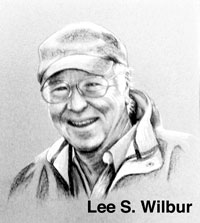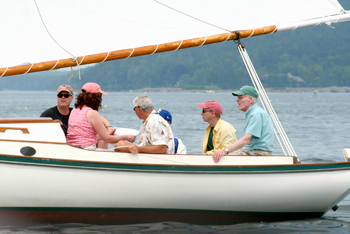70s Memories: Jarvis Newman
by Lee S. Wilbur

First time I recall actually meeting Jarvis was sometime in the late 60s when he and his wife Susan had purchased the only laundromat in Southwest Harbor. He then proceeded to build an extra large “garage” in the back to build rowboats. We both grew up in Southwest, but Jarvis had graduated in 1956, six years before me and young kids were in awe of olders. Besides, he lived way down in Seawall, two miles away. “Jarv” had spent two years at Wentworth Institute in Aeronautics Maintenance, then went out to Cincinnati to test jet engines for GE. Stayed there four years. Enjoyed the work, but as a lot of coastal Mainers, missed the salt water. He and Susan Bunker were married in 1961 and moved to Lynn, Massachusetts where he worked two more years for GE. From there it was Marblehead and a job with Stanley Elevator for what Sue termed “half pay.” In the summer of ‘64 they had moved back to Southwest. That fall Jarvis went to work for the Henry R. Hinckley Co. in their fledgling fiberglass department where he picked up his lifelong association with fiberglass. Again at half pay.
Jarvis began to realize,
there was more future
in the larger boats.
The first rowboat Jarvis built in his “garage” was not a great model. Nowheres near as pretty nor as good a rower as his second, one designed and built by Arthur Spurling from Islesford. As Jarvis began to realize, there was more future in the larger boats, he decided in 1967 to leave HRH Co. and begin building a 25' Friendship Sloop in fiberglass taken from a model James “Pebble” Rockefeller had built in 1965 at Bald Mt. Boatworks named “Old Baldy.”
Wasn’t long before Jarvis and Susan realized Newman and Company had outgrown the laundromat business and large garage fiberglass production, and moved down to Manset and a house owned by Jarvis great-aunt. It was a house big enough for the now family of four, which included lovely daughters Kim and Kathy. A proper boat shed was soon built from which Friendship hulls and decks as well as the first powerboat hull, a Hunt 25' Surfhunter model, began to roll out the doors. Jarvis had hired his first employee, Roland Stanley, and soon after, Roy Sprague, both from Southwest, and between these three men, large amounts of fiberglass were converted to boats to sail upon the waters. Long days and weekends were of the order.

Jarvis Newman, right, at the tiller on Friendship sloop Osprey.
I was fascinated watching and talking with Jarvis. Two things caught my attention: hard work and the reward of completing a product to be proud of. Remember well having a conversation with Jim Willis who owned The Boathouse, a small boat storage, repair, sales and rental yard across the street, as we stood watching Jarvis and crew preparing a Bunker and Ellis 36 to be added to the Jarvis Newman Inc. line, and Jim saying, “He’s finally got it right. He’ll do much better with those powerboat hulls than fooling around with Friendship and go-fast models. You mark my words.” Jim couldn’t have been more right. Little did I realize as well, I would someday be in the business of finishing some of these Newman Hulls.
Orders began to pour in for the now named Newman 36. Both commercial and pleasure, aided in no small way by Raymond Bunker’s, (Susan’s father) reputation as a hull designer, caught on immediately. At one time, there was a completed hull going out the door every eleven days. And, as Jarvis was ever quick to point out as competitors surfaced and time savers were invented, “We build ‘em with buckets and hand rollers. No sprayed chopped glass and resin. This is the best, the best. Strongest hulls.” Course it took awhile to realize the many benefits of “glass” and was no longer necessary to follow the old Maine adage of “if one plank will do add another.” Fiberglass did not have to be as thick as wood and yes, a 30.30 bullet would penetrate, but with a lot more difficulty than through a cedar or mahogany plank.
I came on the boatbuilding scene purely by chance in 1973 when good friend and mentor, Les King, suggested after a career change I should go into boatbuilding. Jarvis was looking for shops to finish off his hulls and soon introduced my next door neighbor, Roger Pinkham, and I to our first customer. From there, we became close friends. Jarvis and Sue, Heidi and I did boat shows together, sailed in the Carribean, and partied. Jarvis and I spent hours on the phone after the workday going over ideas and problems. Jarvis, ever since I’ve known him, has been able to spot opportunities. He’s, not to give Sue a back seat, been able to see the next step in hull building, or purchase property, upgrade it, then successfully sell it and move on. One of his favorite phrases to this day is “Dollars, Dollars, Dollars!”
Alfred Osgood told
the story of coming back
from offshore through an “hellacious” storm, through
towers of water in his 46'.
The Bunker and Ellis 36' was soon followed by a Ralph Stanley 32' and then another Friendship Sloop. This one built in 1904 owned by the Chesney family on Deer Isle which Jarvis re-finished and took a mould. The original was sold to a Doctor in Nyack then sold to a school. Much later, Jarvis bought it back. Refurbished it again and sold it back to a son in the Chesney family who converted it back to a “working Friendship” and now resides once again in Deer Isle.
By 1977 commercial fishermen were looking for bigger boats to go offshore lobstering, gillnetting, and for inshore dragging. The 200 mile limit had finally been passed, too late as always by our dithering Congress, and waterfront excitement was in the air. Jarvis hired Royal Lowell of Lowell and Spaulding, a well known designer of semi-displacement Maine lobsterboats, to design what I have always felt was Royal’s best, a 46'. Again, Jarvis had hit the timing. This model was fun to build as well as being exceptionally seaworthy. Roomy, we could put a workshop of tools aboard as we built. Go to building in the morning, stay on board all day except for trips to the stockrooms for wood and parts. Alfred Osgood told the story of coming back from offshore through an “hellacious” storm, through towers of water where they had to steer between the towers in his 46. Pleasure boats, we could do two good staterooms below, two heads and adjoining shower, with large salon and ample galley. Great model.
In 1978, Jarvis had decided to sell. He’d been breathing the fumes on a daily basis for long enough and I suspect his timing was a factor as well when he sold the company to Lewis Moore from Northeast Harbor, and Wayne Wibby, a dentist from Bangor. Dr. Wayne left in 1979 and the business continued for several years after. Today, Jarvis, with daughter Kathy, owns and operates Newman Boat Brokerage, and Jarvis, who never could be idle, repairs and finishes various boats in a new shed behind the brokerage office.
This story originally appeared in the Fishermen’s Voice in April 2006.
Jarvis Newman (1935–2019) passed away on September 1, 2019 in Bar Harbor.
• R E C I P E •
Fall Salad Recipe
This is a very simple recipe, one to be made after raking leaves all day … or romping through the woods enjoying the fall colors as we did this past week … enjoy!!
Apples, celery, carrots (preferably the multicolored, that way spouse or guests will “thumbs up the great variety” all cut into 1/2" to 3/4" pieces along with smallish pieces of green lettuce. Toss in a bowl. Add dressing mixed of:
1 T mayo
1 T regular olive oil
2 T seasoned rice vinegar
(“Nakano”) if available—great stuff for dressings)
We did this one tonight, and I’m getting psyched all over to start again with a cookbook.
